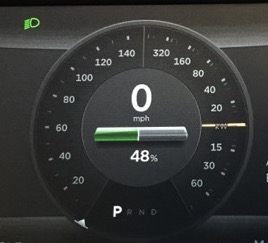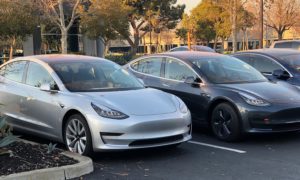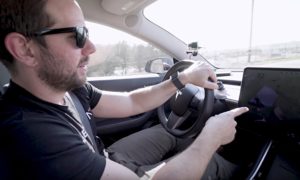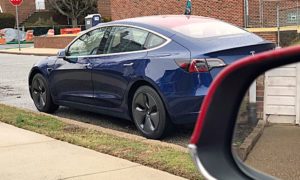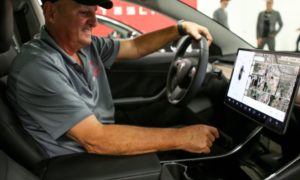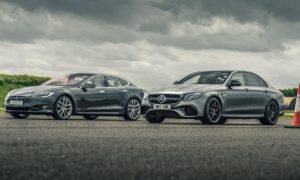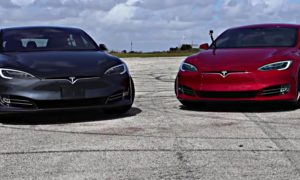News
Tesla Firmware 6.1: Range, Routes and Parking Aid
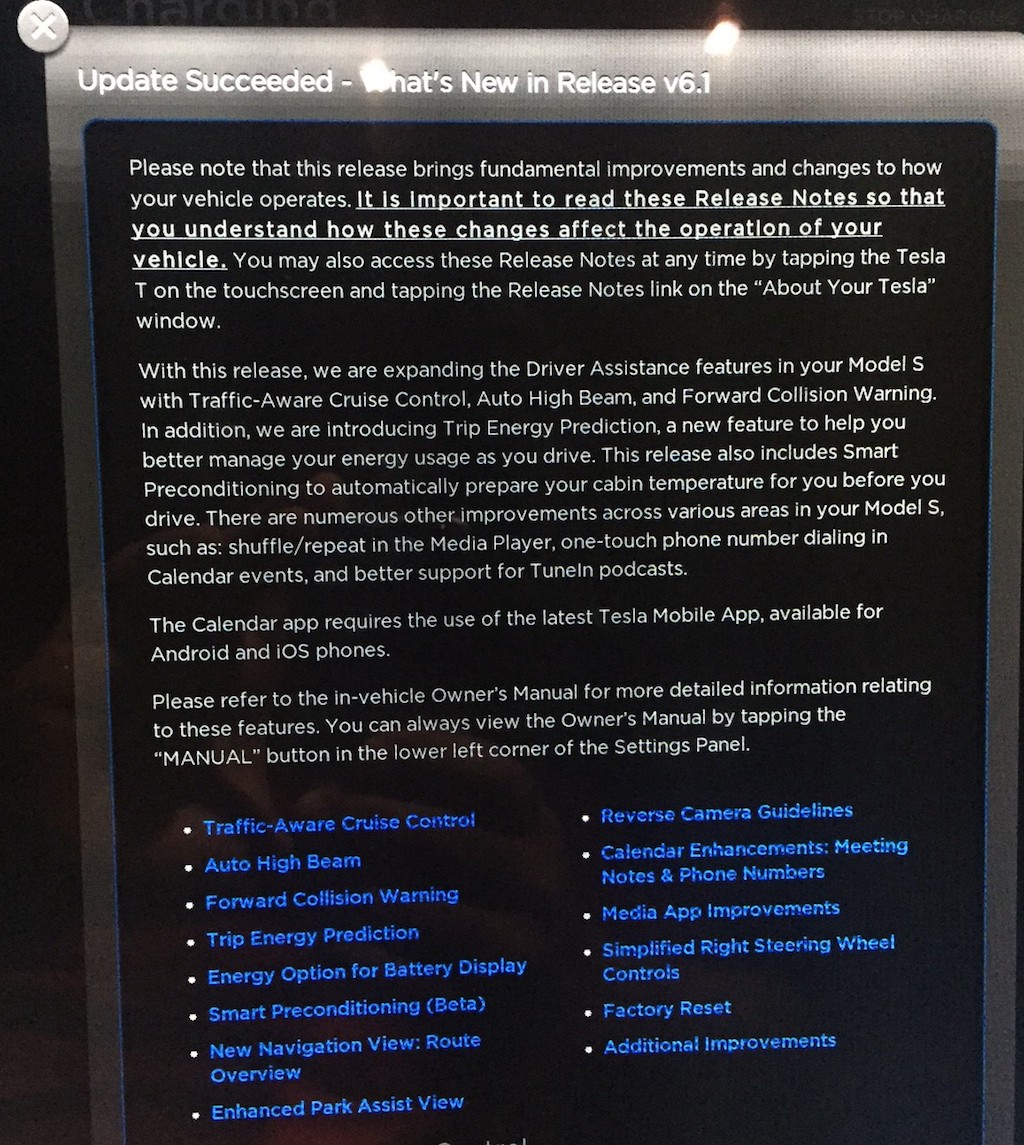
Following the review of Firmware 6.1’s Trip Energy Prediction roll out I’ll be taking a deeper look at some of the other major features that came bundled with this version such as navigation routing and the reverse camera parking aid.
Range Display: Battery %
The Model S displays battery range based on a rated or ideal measurement as determined by the methodology in which the US EPA measures electric vehicle range.
This range always seems to be a hot topic of discussion amongst owners since, almost always, the actual mileage achieved is lower than what’s displayed on the car’s dash. This is especially true during the cold New England winter months when 265 miles of rated range turns out to be closer to 160 miles of actual range due to the effects of winter driving.
The grim reality is that range based on distance (mi/km) will vary depending on how you drive, the terrain you drive on and the environmental conditions during that time.
Tesla Firmware 6.1 solves this issue by giving drivers the ability to replace the display of range with the percentage of battery life remaining. Sure there’s the color-coded battery indicator but being able to see an actual value makes it much more relatable. On top of that the amount of battery remaining lines up nicely to the energy graph displayed through the Trip Energy Prediction feature.
Using this new way of measuring your range takes some getting used to but after a week of using it I kind of like it. It certainly beats using a rated range display that ends up being off by 40-50% during the winter months.
Route Overview
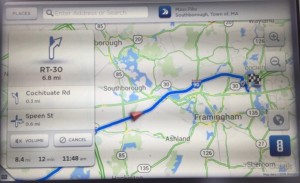 Tesla Firmware 6.1 also adds a new view for trip routing. A “Route Overview” option allows you to visualize your route using a north up view but with the ability to automatically zoom in as you approach your destination. There’s no need to manually pinch zoom anymore..
Tesla Firmware 6.1 also adds a new view for trip routing. A “Route Overview” option allows you to visualize your route using a north up view but with the ability to automatically zoom in as you approach your destination. There’s no need to manually pinch zoom anymore..
Enhanced Park Assist and Camera Guidelines
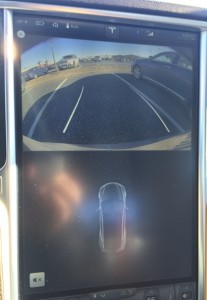 I’m lumping these two features together but also keeping in mind that Park Assist is limited to those with the parking assist package.
I’m lumping these two features together but also keeping in mind that Park Assist is limited to those with the parking assist package.
With this new update putting the Model S in reverse will display both front and rear parking sensors making parallel parking and backing into tight spots that much easier. You also have the ability to manually trigger Park Assist as long as the car is traveling below 5mph. This is a great addition since it provides visibility for all four corners of the Model S.
Tesla finally put the rumors of having an inadequate graphics engine, that supposedly prevented the ability to render parking lines, to rest with the addition of the reverse camera guidelines.
I never had rear camera guidelines on any of my previous cars so this feature wasn’t on my wish list and I never really understood why so many people wanted them. Now that I have them I can see how it would be hard to ever go back to a car without them.
Rear camera guidelines was the #1 requested feature for years and Tesla has delivered!
Summarizing the feature, the Model S will overlay lines on the screen to indicate the path of travel when backing up. These lines move with your steering wheel and apparently the lines will change colors to ensure maximum contrast and visibility depending on the background. Here’s a video of it in action.
Summary
Tesla outdid itself with this the release of Firmware 6.1. It introduces a solid list of big features and improvements around range, routing displays and parking assistance. Combine this with the new feature to dynamically calculate range based on terrain and driving behavior, this is one of the best updates to date.
Stay tuned as I review some of the other enhancements that came bundled with this version.
News
Tesla launches in India with Model Y, showing pricing will be biggest challenge
Tesla finally got its Model Y launched in India, but it will surely come at a price for consumers.

Tesla has officially launched in India following years of delays, as it brought its Model Y to the market for the first time on Tuesday.
However, the launch showed that pricing is going to be its biggest challenge. The all-electric Model Y is priced significantly higher than in other major markets in which Tesla operates.
On Tuesday, Tesla’s Model Y went up for sale for 59,89,000 rupees for the Rear-Wheel Drive configuration, while the Long Range Rear-Wheel Drive was priced at 67,89,000.
This equates to $69,686 for the RWD and $78,994 for the Long Range RWD, a substantial markup compared to what these cars sell for in the United States.
🚨 Here’s the difference in price for the Tesla Model Y in the U.S. compared to India.
🚨 59,89,000 is $69,686
🚨 67,89,000 is $78,994 pic.twitter.com/7EUzyWLcED— TESLARATI (@Teslarati) July 15, 2025
Deliveries are currently scheduled for the third quarter, and it will be interesting to see how many units they can sell in the market at this price point.
The price includes tariffs and additional fees that are applied by the Indian government, which has aimed to work with foreign automakers to come to terms on lower duties that increase vehicle cost.
Tesla Model Y seen testing under wraps in India ahead of launch
There is a chance that these duties will be removed, which would create a more stable and affordable pricing model for Tesla in the future. President Trump and Indian Prime Minister Narendra Modi continue to iron out those details.
Maharashtra Chief Minister Devendra Fadnavis said to reporters outside the company’s new outlet in the region (via Reuters):
“In the future, we wish to see R&D and manufacturing done in India, and I am sure at an appropriate stage, Tesla will think about it.”
It appears to be eerily similar to the same “game of chicken” Tesla played with Indian government officials for the past few years. Tesla has always wanted to enter India, but was unable to do so due to these import duties.
India wanted Tesla to commit to building a Gigafactory in the country, but Tesla wanted to test demand first.
It seems this could be that demand test, and the duties are going to have a significant impact on what demand will actually be.
Elon Musk
Tesla ups Robotaxi fare price to another comical figure with service area expansion
Tesla upped its fare price for a Robotaxi ride from $4.20 to, you guessed it, $6.90.

Tesla has upped its fare price for the Robotaxi platform in Austin for the first time since its launch on June 22. The increase came on the same day that Tesla expanded its Service Area for the Robotaxi ride-hailing service, offering rides to a broader portion of the city.
The price is up from $4.20, a figure that many Tesla fans will find amusing, considering CEO Elon Musk has used that number, as well as ’69,’ as a light-hearted attempt at comedy over the past several years.
Musk confirmed yesterday that Tesla would up the price per ride from that $4.20 point to $6.90. Are we really surprised that is what the company decided on, as the expansion of the Service Area also took effect on Monday?
But the price is now a princely $6.90, as foretold in the prophecy 😂
— Elon Musk (@elonmusk) July 14, 2025
The Service Area expansion was also somewhat of a joke too, especially considering the shape of the new region where the driverless service can travel.
I wrote yesterday about how it might be funny, but in reality, it is more of a message to competitors that Tesla can expand in Austin wherever it wants at any time.
Tesla’s Robotaxi expansion wasn’t a joke, it was a warning to competitors
It was only a matter of time before the Robotaxi platform would subject riders to a higher, flat fee for a ride. This is primarily due to two reasons: the size of the access program is increasing, and, more importantly, the service area is expanding in size.
Tesla has already surpassed Waymo in Austin in terms of its service area, which is roughly five square miles larger. Waymo launched driverless rides to the public back in March, while Tesla’s just became available to a small group in June. Tesla has already expanded it, allowing new members to hail a ride from a driverless Model Y nearly every day.
The Robotaxi app is also becoming more robust as Tesla is adding new features with updates. It has already been updated on two occasions, with the most recent improvements being rolled out yesterday.
Tesla updates Robotaxi app with several big changes, including wider service area
News
Tesla Model Y and Model 3 dominate U.S. EV sales despite headwinds
Tesla’s two mainstream vehicles accounted for more than 40% of all EVs sold in the United States in Q2 2025.

Tesla’s Model Y and Model 3 remained the top-selling electric vehicles in the U.S. during Q2 2025, even as the broader EV market dipped 6.3% year-over-year.
The Model Y logged 86,120 units sold, followed by the Model 3 at 48,803. This means that Tesla’s two mainstream vehicles accounted for 43% of all EVs sold in the United States during the second quarter, as per data from Cox Automotive.
Tesla leads amid tax credit uncertainty and a tough first half
Tesla’s performance in Q2 is notable given a series of hurdles earlier in the year. The company temporarily paused Model Y deliveries in Q1 as it transitioned to the production of the new Model Y, and its retail presence was hit by protests and vandalism tied to political backlash against CEO Elon Musk. The fallout carried into Q2, yet Tesla’s two mass-market vehicles still outsold the next eight EVs combined.
Q2 marked just the third-ever YoY decline in quarterly EV sales, totaling 310,839 units. Electric vehicle sales, however, were still up 4.9% from Q1 and reached a record 607,089 units in the first half of 2025. Analysts also expect a surge in Q3 as buyers rush to qualify for federal EV tax credits before they expire on October 1, Cox Automotive noted in a post.
Legacy rivals gain ground, but Tesla holds its commanding lead
General Motors more than doubled its EV volume in the first half of 2025, selling over 78,000 units and boosting its EV market share to 12.9%. Chevrolet became the second-best-selling EV brand, pushing GM past Ford and Hyundai. Tesla, however, still retained a commanding 44.7% electric vehicle market share despite a 12% drop in in Q2 revenue, following a decline of almost 9% in Q1.
Incentives reached record highs in Q2, averaging 14.8% of transaction prices, roughly $8,500 per vehicle. As government support winds down, the used EV market is also gaining momentum, with over 100,000 used EVs sold in Q2.
Q2 2025 Kelley Blue Book EV Sales Report by Simon Alvarez on Scribd
-

 News3 days ago
News3 days agoTesla debuts hands-free Grok AI with update 2025.26: What you need to know
-

 Elon Musk1 week ago
Elon Musk1 week agoElon Musk confirms Grok 4 launch on July 9 with livestream event
-

 Elon Musk5 days ago
Elon Musk5 days agoxAI launches Grok 4 with new $300/month SuperGrok Heavy subscription
-

 News2 weeks ago
News2 weeks agoTesla Model 3 ranks as the safest new car in Europe for 2025, per Euro NCAP tests
-

 Elon Musk2 weeks ago
Elon Musk2 weeks agoxAI’s Memphis data center receives air permit despite community criticism
-

 News5 days ago
News5 days agoTesla begins Robotaxi certification push in Arizona: report
-

 Elon Musk2 weeks ago
Elon Musk2 weeks agoTesla reveals it is using AI to make factories more sustainable: here’s how
-

 Elon Musk2 weeks ago
Elon Musk2 weeks agoTesla scrambles after Musk sidekick exit, CEO takes over sales

